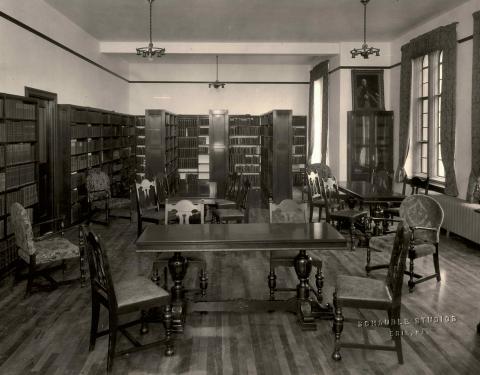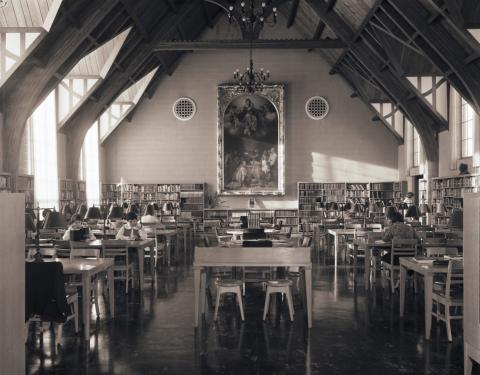History of Hammermill Library

With the exponential expansion of Mercyhurst since its opening in 1926, it is no surprise that the older buildings have served varied functions over the years, with departments and academic services shifting location to accommodate the changing needs of students and staff. One of the most ‘nomadic’ services on campus has been the Mercyhurst Library. Today, it is hard to imagine Mercyhurst without Hammermill Library, the large, modern facility that welcomes students to study and investigate library resources. But when the college opened in 1926, all its facilities—dormitories, classrooms, gymnasium, dining hall, and more—were contained within what are now Old Main and Egan Hall. During those early years, the college library was located in a single room on Old Main’s second floor. It held over 8,000 books—an impressive number at the time, especially considering the limitations of the space.
This arrangement was short-lived. When O’Neil Tower was constructed in the early 1930s, the library took up residence on the tower’s second floor and consisted of a reading room and collection of materials. O’Neil Tower provided more space for students wishing to consult library materials and study, proving to be a more feasible location.

In 1952, ground was broken for Weber Hall, located adjacent to Old Main. Weber Hall was to hold a Little Theater on its lower level and a new library facility on the upper floor; This was the first time the college library had a free-standing building since it had previously taken up space in buildings with other functions. The Weber Library provided more space, plus an impressive view of the front of campus through its floor-to-ceiling windows. Finally, the library had a more permanent home on campus—or so the Mercyhurst community thought.
When Sister Carolyn Herrmann became president in the early 1960s, she anticipated that the college would need significant expansion to accommodate its growth. Accordingly, she launched Mercyhurst’s first capital campaign, which was a resounding success. Funds from the campaign financed the construction of multiple new buildings, including a Learning Resource Center. The Learning Resource Center opened in 1971. It was initially a three-floor building with a rather boxy shape, located 100 feet further west than initially intended due to the discovery of an underground waterway. At the time it opened, the college library contained 65,000 volumes – clearly, expansion was a wise move. The Learning Resource Center housed these volumes, plus study rooms and an archival center.

The Learning Resource Center would undergo significant changes in the years to come. First, in 1985, its name was changed to Hammermill Library to commemorate a financial contribution from the Hammermill Foundation. In the 1990s, the Board of Trustees approved a $500,000 plan to automate the library, bringing it up-to-date with a world of changing technology. The addition of the Walker Wing, dedicated in 1998, added the Barrett Walker Computer Room and Catherine Walker Reading Room and connected Hammermill Library to Weber Hall. Weber Hall, which had been converted to a dance studio after the construction of the Learning Resource Center, was restored almost identically to its original library appearance in 1998 so that students could once again study in the Weber Great Room. Finally, the construction of a fourth floor – which added a Gothic-style exterior to the previously plain building – brought the Hammermill Library into architectural sync with other buildings on campus.
Since then, Hammermill Library has continued to expand its functionality. With the dedication of the Sister Mary Lawrence Franklin Archival Center in 1995, the Mercyhurst Archives, housed on the third floor of Hammermill, have expanded and modernized. Mercyhurst’s Hospitality Department operated a student-run café, Café Diem, in Hammermill Library from 2001 until 2017, when the café moved to the Center for Academic Engagement. Most recently, a million-dollar gift from the corporation MCPs in 2017 helped to fund a state-of-the-art cyber lab on the bottom floor of Hammermill to house the new Cybersecurity program. In 2019, Hammermill underwent a makeover, as a massive renovation to its first floor made the space more attractive and functional. Today, students can access an endless supply of academic materials, including hundreds of thousands of ebooks.
Mercyhurst’s library has come a long way from its humble beginnings in a single room in Old Main. While its history has involved a great deal of relocation and change, it seems that Hammermill Library will continue to be the perfect home for Mercyhurst’s library services for years to come.